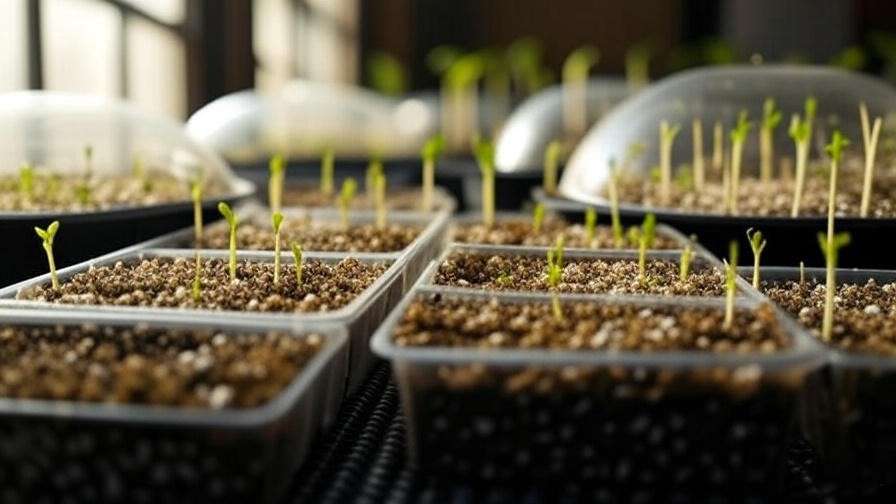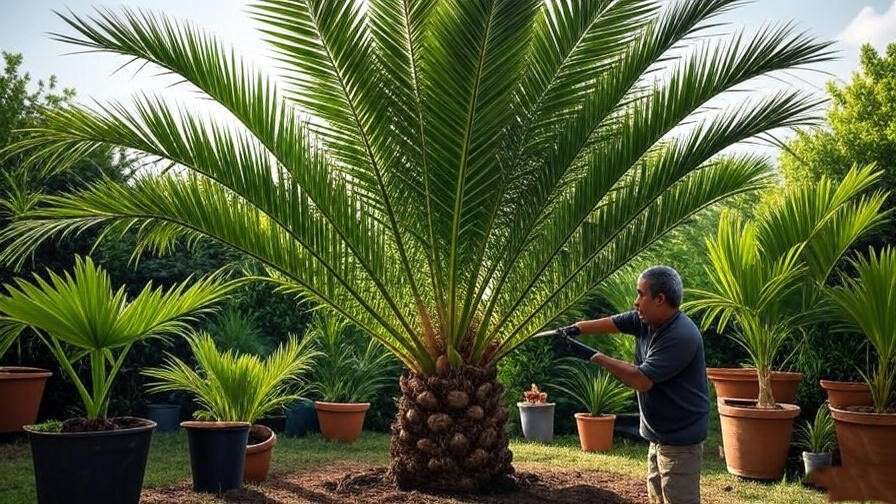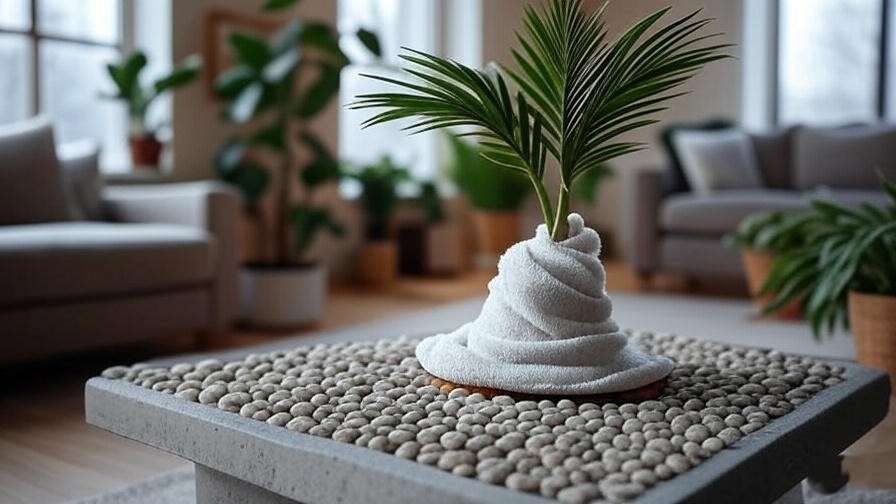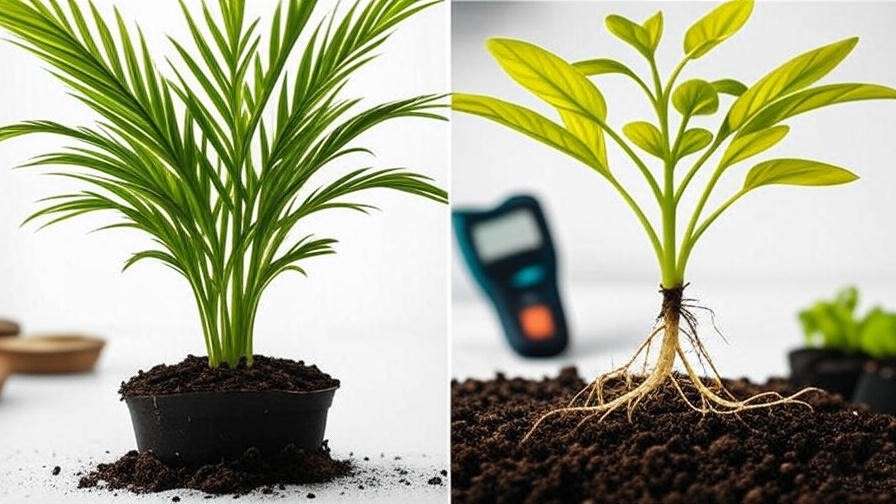Imagine transforming your backyard or living room into a lush, tropical paradise with towering palm trees you grew yourself—from tiny seeds! Growing palm tree seeds is not only a rewarding journey for plant enthusiasts but also an affordable way to cultivate exotic greenery. Whether you’re a beginner dreaming of a coconut palm swaying in your garden or a seasoned gardener seeking to master propagation, this comprehensive guide will walk you through every step to successfully germinate and nurture palm tree seeds. Backed by decades of horticultural expertise, we’ll share proven techniques, practical tips, and expert insights to ensure your success. Let’s dive into the world of palm cultivation and bring your tropical vision to life!
1. Understanding Palm Tree Seeds 🌿
1.1 What Are Palm Tree Seeds?
Palm tree seeds, often referred to as palm nuts or kernels, are the reproductive units of palm trees, used to propagate new plants. These seeds vary widely across the 2,600+ species of palms, from the large, hard-shelled coconut to the small, berry-like seeds of the parlor palm. Each species has unique seed characteristics, such as size, shape, and germination requirements, which influence how they’re handled. Understanding these differences is key to successful propagation, as improper handling can lead to low germination rates. For instance, coconut seeds require soaking and warmth, while date palm seeds benefit from scarification.
1.2 Why Grow Palms from Seeds?
Growing palms from seeds is a cost-effective alternative to purchasing mature plants, which can be expensive. It’s also deeply satisfying to nurture a tiny seed into a majestic tree. Palms contribute to a greener environment by sequestering carbon and providing shade or habitat for wildlife. For example, Sarah, a home gardener in Florida, successfully grew a royal palm from seed, transforming her backyard into a tropical haven for under $10. Beyond aesthetics, palms can increase property value and create a relaxing atmosphere, making seed propagation a worthwhile endeavor for beginners and experts alike.
2. Choosing the Right Palm Tree Seeds 🏝️
2.1 Popular Palm Species for Beginners
Selecting the right palm species is crucial for beginners. Here are three beginner-friendly options:
- Parlor Palm (Chamaedorea elegans): Compact and shade-tolerant, ideal for indoor growing. Seeds germinate in 2–3 months.
- Areca Palm (Dypsis lutescens): A fast-growing, feathery palm perfect for warm climates or bright indoor spaces. Germination takes 6–8 weeks.
- Sago Palm (Cycas revoluta): Technically not a true palm, but its seeds are easy to germinate, and it thrives in pots.
Each species has distinct growth rates and care needs, so choose based on your climate, space, and commitment level.
2.2 Where to Source Quality Seeds
Fresh, viable seeds are critical for success. Purchase from reputable sources like local nurseries, botanical gardens, or trusted online retailers such as Rare Palm Seeds or Plant Delights Nursery. Look for seeds harvested within the past 6–12 months, as older seeds lose viability. Check for firm, plump seeds without cracks or mold. Avoid buying from unverified sellers on marketplaces, as they may offer low-quality or improperly stored seeds. For example, seeds stored in overly dry conditions can become dormant, reducing germination rates.
2.3 Expert Tip
“Always prioritize fresh seeds from a reliable source,” says Dr. Emily Carter, a horticulturist with 20 years of experience in tropical plant propagation. “Fresh palm seeds can have germination rates as high as 80%, while older seeds may drop to 20% or less.”
3. Preparing Palm Tree Seeds for Planting 🌞
3.1 Cleaning and Soaking Seeds
Proper preparation sets the stage for germination. Start by cleaning seeds to remove any pulp or husk, which can harbor fungi. For example, coconut seeds need their outer husk partially removed, while date palm seeds require pulp removal with a gentle scrub. Soak seeds in warm water (75–85°F) for 24–72 hours, changing the water daily to prevent bacterial growth. Adding a drop of gibberellic acid (available at gardening stores) can speed up germination for slow species like the Bismarck palm.

3.2 Scarification and Stratification
Some palm seeds, like those of the queen palm, have hard coats that require scarification—lightly sanding or nicking the seed coat to allow water penetration. Use a fine sandpaper or a small knife, being careful not to damage the embryo. Stratification, or exposing seeds to cold, is rarely needed for tropical palms but may benefit cold-tolerant species like the windmill palm. Below is a quick guide:
| Palm Species | Scarification Needed? | Soaking Duration |
| Coconut Palm | No | 48–72 hours |
| Date Palm | Yes | 24–48 hours |
| Parlor Palm | No | 24 hours |
4. Germinating Palm Tree Seeds 🌱
4.1 Creating the Ideal Germination Environment
Palm seeds thrive in warm, humid conditions mimicking their tropical origins. Maintain a temperature of 75–85°F using a heat mat or propagator. High humidity (70–90%) prevents seeds from drying out. Use a sterile germination medium like a 1:1 mix of perlite and peat moss for excellent drainage and aeration. Avoid direct sunlight, as it can overheat seeds; instead, provide bright, indirect light. A clear plastic cover over the container can help retain moisture.

4.2 Step-by-Step Germination Process
- Prepare Containers: Use 4-inch pots or seed trays with drainage holes.
- Plant Seeds: Bury seeds at a depth equal to their diameter (e.g., 1-inch seeds go 1 inch deep).
- Moisten Medium: Keep the medium consistently moist but not waterlogged.
- Cover and Monitor: Place containers in a warm, humid spot and check weekly for sprouts.
Germination times vary—parlor palms may sprout in 6 weeks, while coconut palms can take 6 months.
4.3 Troubleshooting Germination Issues
If seeds aren’t sprouting, common issues include:
- Fungal Growth: Ensure sterile conditions and avoid overwatering. Use a fungicide if needed.
- Low Temperature: Check that the environment stays above 75°F.
- Non-Viable Seeds: Test viability by placing seeds in water; floaters are likely dead.
Re-soak or adjust conditions as needed, and be patient—some palms are notoriously slow.
5. Caring for Palm Seedlings 🌴
5.1 Transplanting Seedlings
Once your palm tree seeds sprout, the seedlings need careful handling to thrive. Transplant them when they develop their first true leaves, typically 2–4 months after germination. Choose 6-inch pots with drainage holes to accommodate growing roots. Use a well-draining soil mix, such as 50% potting soil, 25% sand, and 25% perlite, to prevent root rot. Gently lift seedlings, keeping the root ball intact, as palms are sensitive to root disturbance. For example, Areca palm seedlings can suffer stunted growth if roots are damaged during transplanting. Water lightly after transplanting and place in a warm, shaded area for a week to reduce shock.

5.2 Watering and Fertilizing
Watering palm seedlings requires a delicate balance. Keep the soil consistently moist but never soggy—overwatering is a leading cause of seedling failure. Use a spray bottle for small seedlings to avoid dislodging them. Once established, water when the top inch of soil feels dry. Fertilize monthly with a balanced, slow-release fertilizer (e.g., 10-10-10 NPK) diluted to half strength to avoid burning tender roots. Watch for signs of nutrient deficiency, like yellowing fronds, which may indicate a lack of nitrogen or potassium. Adjust fertilization if needed, and always water before applying fertilizer to enhance absorption.
5.3 Light and Temperature Requirements
Palm seedlings thrive in bright, indirect light, mimicking the dappled sunlight of their natural habitats. Place them near a south-facing window indoors or in a shaded outdoor area. Avoid direct sunlight, which can scorch young leaves. Maintain temperatures between 70–80°F for optimal growth; temperatures below 60°F can slow development or cause stress. For outdoor transitions, gradually acclimate seedlings over 7–10 days by increasing sun exposure daily. For example, a parlor palm seedling moved directly to full sun may wilt, but gradual hardening ensures resilience.
6. Long-Term Palm Tree Care 🌞
6.1 Pot vs. Ground Planting
Deciding whether to grow palms in pots or in the ground depends on your climate and space. Potted palms are ideal for indoor environments or regions with cold winters, allowing mobility and protection. Use pots with drainage holes and repot every 2–3 years to refresh soil and accommodate growth. Ground planting suits warm climates (USDA zones 9–11) and requires well-draining, loamy soil with a pH of 6.0–7.0. Choose a site with partial shade for young palms, transitioning to full sun for mature plants like coconut or date palms. Ensure proper spacing (e.g., 10–15 feet for large species) to avoid crowding.
6.2 Pruning and Maintenance
Pruning keeps palms healthy and attractive. Remove only dead, brown fronds, as green fronds are vital for photosynthesis. Use clean, sharp shears to avoid spreading disease. For pest control, watch for common issues like spider mites or scale insects, which appear as tiny dots or sticky residue on leaves. Treat with neem oil or insecticidal soap, applied early in the morning for best results. Regular cleaning of fronds with a damp cloth removes dust and enhances light absorption, especially for indoor palms.

6.3 Seasonal Care Tips
- Winter: Protect cold-sensitive palms (e.g., coconut or Areca) by moving potted plants indoors or covering outdoor palms with frost cloth. Maintain humidity with a pebble tray or humidifier.
- Summer: Increase watering during hot months, but ensure proper drainage. Mist leaves to combat dry air and promote vibrant growth.
For example, a Florida gardener successfully overwintered a young royal palm by wrapping it in burlap, demonstrating the value of proactive seasonal care.

7. Common Mistakes to Avoid 🚫
Beginners often encounter setbacks when growing palm tree seeds. Here are the top mistakes and how to avoid them:
- Overwatering: Leads to root rot. Use a moisture meter to gauge soil dampness.
- Poor Seed Quality: Always buy from reputable sources and test seed viability.
- Incorrect Soil: Avoid heavy, clay-based soils; opt for a well-draining mix.
- Rushing Germination: Patience is key—some palms take months to sprout.
For example, John, a novice gardener, lost his first batch of date palm seeds to overwatering but succeeded on his second try by using a well-draining mix and a heat mat.

8. Expert Insights and Pro Tips 🧑🌾
To elevate your palm-growing game, consider these advanced techniques:
- Mycorrhizal Fungi: Adding beneficial fungi to the soil can enhance root growth and nutrient uptake. Products like MycoApply are available at specialty nurseries.
- Humidity Domes: For slow-germinating species, use a clear plastic dome to maintain high humidity without constant watering.
- Sustainable Practices: Opt for eco-friendly pots made from coir or recycled materials and use organic fertilizers to minimize environmental impact.
Dr. Maria Lopez, a botanist specializing in tropical plants, advises, “Consistency in warmth and humidity is the secret to palm seed germination. Mimic their natural environment, and you’ll see success.”
9. FAQs About Growing Palm Tree Seeds ❓
Q1: How long does it take for palm tree seeds to germinate?
A: Germination times vary by species—parlor palms may sprout in 6–8 weeks, while coconut palms can take 4–6 months. Ensure optimal warmth and humidity to speed up the process.
Q2: Can I grow palm trees indoors?
A: Yes, species like parlor or Areca palms thrive indoors with bright, indirect light and proper care. Ensure good air circulation and avoid overwatering.
Q3: What should I do if my palm seeds aren’t sprouting?
A: Check temperature, moisture, and seed viability. Re-soak seeds, adjust conditions, or try a heat mat to stimulate germination.
Q4: Are palm trees safe for pets?
A: Most true palms (e.g., parlor, Areca) are non-toxic, but sago palms are highly toxic to pets. Always verify species safety with resources like the ASPCA.
Q5: How do I know if my palm seeds are viable?
A: Perform a float test—viable seeds typically sink in water, while floaters are often non-viable. Freshness is key, so purchase from trusted suppliers.
10. Conclusion 🌴
Growing palm tree seeds is a fulfilling journey that transforms tiny kernels into stunning tropical trees. By choosing quality seeds, preparing them properly, and providing consistent care, you can cultivate your own palms with confidence. From germination to long-term maintenance, this guide has equipped you with expert-backed steps to succeed, whether you’re creating an indoor jungle or a backyard oasis. Start your palm-growing adventure today, and share your progress with fellow plant lovers on platforms like X! For more tropical plant tips, check out our guides on indoor palm care or tropical plant propagation.













